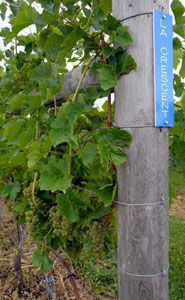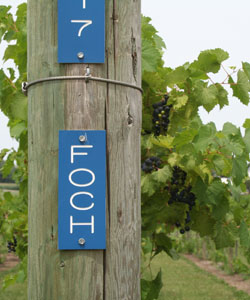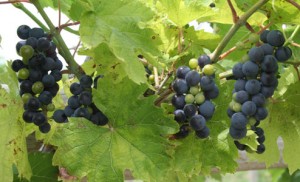Leaf Thinning at Tassel Ridge
Pruning at Tassel Ridge with the V-Mech Pruner
Pruning at Tassel Ridge
Tassel Ridge Grape Varietal Facts
References:Smiley, Lisa. “Review of Cold Climate Cultivars.” Viticulture Iowa State University. October 2008. Iowa State University Extension. August 2009. *The “Review of Cold Climate Cultivars” was submitted by Lisa Ann Smiley in partial fulfillment of the requirements for the Masters of Agriculture degree awarded by Iowa State University in May 2008. Program committee: Paul Domoto, major advisor; Gail Nonnecke and W. Wade Miller committee members.
Brianna
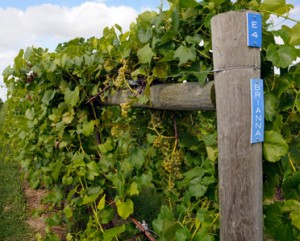
Number of vines: 372
Tassel Ridge Wines: 2008 Iowa Brianna (dry)
Pedigree: ‘Kay Gray’ x E.S. 2-12-13
Origin: Osceola, Wisconsin, Bred by Elmer Swenson
Cross/Selection/Test: Cross made in 1983 selected in 2001 as a wine grape. Named by Ed Swanson, by Cuthills Vineyards, Pierce NE in 2002
Color: White
Berry: Medium-large in size and round in shape; thick skinned greenish-gold berries which turn gold when fully ripened.
Cluster: Medium-small tight clusters. The average cluster weight taken at four Iowa State University research vineyards in 2007 was .24 lb.
Wine Quality & Characteristics: Brianna can be made into a semi-sweet white wine with pronounced pineapple nose and flavor when fully ripe. Also best harvested between 3.2-3.4 pH , adding a little more grapefruit, tropical, and slight floral characteristics. Brianna grapes are high in pectin, and need extra enzymes for a good juice yield.
Season: Early Midseason (mid to late August in Iowa.)
Cold Hardiness: Very hardy, below -20° F
Edelweiss
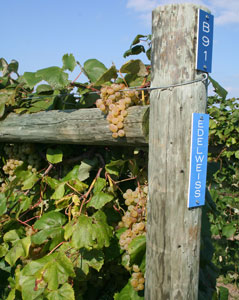
Number of vines: 9,630
Tassel Ridge Wines: Iowa Edelweiss (semi-sweet) (multiple gold medals), White Blossom (dry), Star Spangled White® (sweet)
Pedigree: MN #78 x Ontario
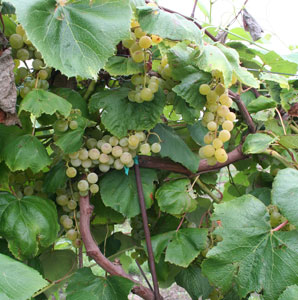
Origin: Osceola, Wisconsin. Developed by Elmer Swenson, P. Pierquet, C. Stushnoff
Release: 1978 by Elmer Swenson and the University of Minnesota
Color: White
Berry: Medium-sized and round; slipskin as green with a white bloom. Flesh is tender and melting; and the flavor is fruity-labrusca, becoming strongly foxy at late maturity.
Cluster: Medium; very loose to moderately compact; conical in shape. Average cluster weight at four Iowa State University research sites in 2007 was .32 lb
Wine Quality & Characteristics: According to Swenson, the white wine from this grape is pleasant if the fruit is picked at an “early mature” stage and wine is finished semi-sweet. It should be harvested early if it is to be used for wine. When completely ripe, it’s labrusca flavors become very strong.
Season: Early (mid-August in Iowa)
Cold hardiness: Very hardy, has survived as low as -32° F
Frontenac
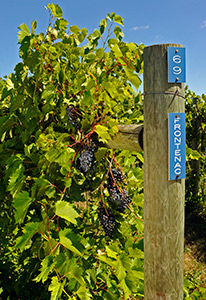
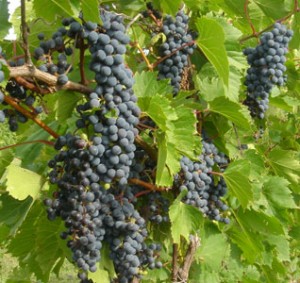
Number of vines: 2388
Tassel Ridge Wines: Frontenac Rosé, Candleglow Red, Finalé Iowa Red
Pedigree: Landot 4511 x University of Minnesota 89
Origin: Excelsior, Minnesota by P.R. Hemstad, J.J. Luby, and P.R. Pierquet
Introduction: 1996
Color: Blue
Berry: Small to medium in size and bluish-black. Also the berries have high skin-pulp ratios and colored pulp, resulting in intense juice color.
Cluster: Cluster are medium-sized, conical in shape. Clusters are loose and berry splitting and bunch rot are rare, even in wet years. Typical clusters weigh .34 lb and 18 cm (7 in) in length.
Wine Quality and Characteristics: In addition to high color, Frontenac carries the vitus riparia traits for high sugar and high acid. As a general rule, aroma and flavor characteristics in Frontenac are dominated by bold cherry notes with lesser hints of black currant and general red fruit. Trained sensory panels have also indentified notes of grass, green bean, evergreen and in some cases chocolate.
When made in the rosé style, the nose and palate showcase a bright, bing cherry note that is enhanced by an off-dry finish and moderate acidity.
As a red wine, the University of Minnesota described a deep garnet color, sometimes tainted with purple. Cherry notes predominate but are typical of black or sweet cherry rather than the brighter notes of the rosé. Earthy and slight herbaceous notes round the palate, supported by a moderate backbone.
Frontenac has also been used to produce port-style wines of outstanding quality. The University of Minnesota found the higher acid levels balance the increased sugar beautifully, deepening the typical fruit notes into lush shades of cherry, raspberry, black currant, and stewed fruits. Some Frontenac ports exhibit chocolate notes which seems dependent on vineyard microclimates.
Season: Midseason, mid-September
Cold hardiness: Very hardy, below -20° F
LaCrescent
Number of vines: 2177
Tassel Ridge Wines: Iowa LaCrescent (new wine), Iowa Prairie Snow
Pedigree: St. Pepin x E.S. 6-8-25
Origin: Excelsior, MN. University of Minnesota Horticultural Research Center, developed by Peter Hemstad and James Luby.
Introduced: 2006
Color: White
Berry: Round; yellow-amber with a waxy bloom when ripe; and fairly small. Flavor fruity, but not foxy. Berries have not been observed to split even in wet years, but in some years a small percentage of berries have been observed dropping from the cluster before or during harvest.
Cluster: Medium-sized, slightly loose to loose and conical, average weight .32 lb, length 15 cm.
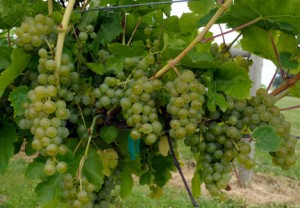
Wine Quality & Characteristics: According to the University of Minnesota, LaCrescent’s intense nose of apricot, peach, and citrus lends itself to superior quality off-dry or sweet white wine. They added it lacks a foxy aroma associated with v. labrusca and herbaceous associated with v. riparia.
Season: Midseason
Cold hardiness: Very hardy, trunks have survived -36° F with only minor bud loss
LaCrosse
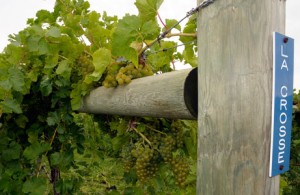
Number of vines: 819
Tassel Ridge Wines: Red, White, & Blue®
Pedigree: (Minn #78 x Seibel 1000) x Seyval Blanc
Origin: Osceola, Wisconsin. Bred by Elmer Swenson
Introduction: 1983
Color: White
Berry: Medium; yellow-green, spherical with tender and juicy pulp. Thin skinned and subject to leaking.
Cluster: More cylindrical than cone shaped; tight, medium-small, average cluster weight is .25 lb
Wine Quality & Characteristics: Aromatics in LaCrosse wines range from pear, apricot and slightly Muscat to citrus and floral. LaCrosse wines have proven to be good as varietals and also have been valuable as blending components for lighter wines, as it adds body and finish. They feel the best wines from LaCrosse have been dry whites fermented in oak, with the acidity softened by malolactic fermentation and that some excellent, semi-dry wines have also been made.
Season: Early Midseason
Cold hardiness: Hardy -15 to -20 ° F
Maréchal Foch
Number of vines: 456
Tassel Ridge Wines: Iowa Nouveau, In the Dark
Pedigree: Debated
Origin: Alsace, France. Bred by Eugene Kuhlmann; Oberlin Institute, Colmer
Introduced: 1920 in France, 1951 in the United States.
Color: Black
Berry: Small, blue-black, round
Cluster: Short (7 to 10 cm), cylindrical; and tight.
Wine Quality & Characteristics: Very good quality red wines have been made from Maréchal Foch. This variety is versatile, and capable of producing fruity light reds to full bodied wines. Wines are said to have a “Burgundy” character while having a somewhat herbaceous flavor and purplish color. May require carbonic maceration or hot-pressing to enhance quality.
Season: Very Early (late August in Iowa)
Cold hardiness: Hardy -15 to -20 ° F
Marquette
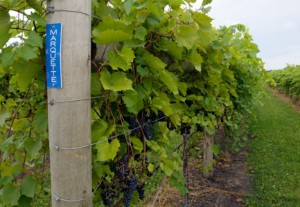
Number of vines: 6,434
Tassel Ridge Wines: First harvest scheduled in 2009; Reserve Marquette & Marquette
Pedigree: MN 1094 & Ravat 262 (offspring of Pinot Noir)
Origin: Excelsior, Minnesota, University of Minnesota Horticultural Research Center, bred by Peter Hemstad & Jim Luby.
Introduced: 2006
Color: Black
Berry: Roundish in shape, and small to medium-sized. Black skinned, bluish bloom, and light pink pulp.
Cluster: Small to medium, (10-11 cm long) and average weight per cluster is .20 lbs.
Wine Quality & Characteristics: Marquette exhibits cherry and black currant flavors and aromas typical of many hybrids. It can be much more complex with integrated notes of blackberries, pepper, plum, tobacco, leather, and spice. It is best utilized when making a medium-bodied red table wine. Research during pre-release harvests had the average Marquette crops at 26.1° Brix, 12.1 g/liter of titratable acidity, and 2.95 pH, but the high level of acidity can be easily managed by experienced winemakers.
Season: Early Midseason (mid-September)
Cold hardiness: Very hardy, -20 to -30 °F has survived as low as -36° without serious injury.
Sabrevois
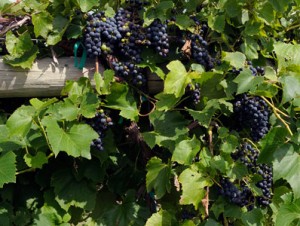
Number of vines: 2,825
Tassel Ridge Wines: Pizzeria & Pasta Too! , possible fortified wines
Pedigree: E.S. 283 & E.S.. 193, Sister of St. Croix
Origin: Osceola, Wisconsin. Bred by Elmer Swenson. Gilles Benoit named cultivar after the village of Sabrevois near Montreal.
Introduction: Has grown in Minnesota for a long time as E.S. 2-1-9, grown in Quebec as ‘Sabrevois’ since around 2000
Color: Black
Berry: Small to medium-sized
Cluster: Small to medium sized, and somewhat loose but well filled. Clusters range from .13 to .26 lbs.
Wine Quality & Characteristics: Juice is not deeply pigmented, but wine can have a very dark color. Sugar content rarely exceeds 20° Brix (even in very ripe fruit) and wines can have a pleasant berry-like fruitiness in the nose and mouth, but tend to lack body and tannin. Can be described as well balanced, low in alcohol and very vinifera-like (similar to Cabernet Franc) Also can make a very highly aromatic rosé if pressed very early, and in a dry red varietal, ‘Sabrevois’ should age well and improve after two years in the bottle. Winemakers also need to manage skin extraction very carefully or they will get the infamous “bacon taint” in the aroma.
Season: Early Midseason
Cold Hardiness: Reported to be hardy to -31° F
St. Croix
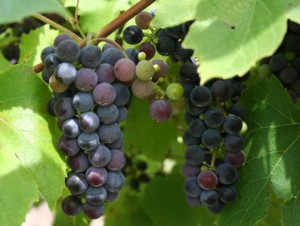
Number of vines: 5,544
Tassel Ridge Wines: In the Dark, Finalé Iowa Red, and St. Croix varietal
Pedigree: E.S. 283 & E.S. 193, Sister of Sabrevois
Origin: Osceola, Wisconsin. Bred by Elmer Swenson
Introduction: 1981
Color: Blue
Berry: Medium-sized spherical; tender and juicy. Very thin skinned and subject to leaking.
Cluster: Slightly cylindrical to conical. Clusters are medium sized, average cluster weight is .22 lbs
Wine Quality & Characteristics: Wines made with St. Croix have been compared to a light to medium burgundy with no foxy or “grapey” flavor. Juice is usually a pale rosé but wines can be quite dark in color. St. Croix can be moderately acidic but grapes struggle to make 20° Brix. Wines tend tend to lack tannics (which can be address with blending) are somewhat neutral and have a tobacco-like nose.
Season: Early Midseason (late August to early September in Iowa)
Cold Hardiness: Very hardy, below -20° F, has survived at -39° F with no winter covering. But roots are a bit less hardy and need snow cover in really cold winters.
St. Pepin
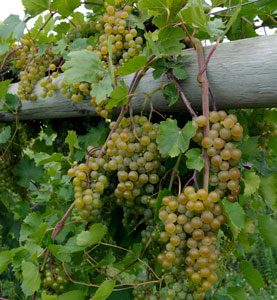
Number of vines: 813
Tassel Ridge Wines: Prelude, Oskyfizzante® Pink, and Iowa Prairie Snow
Pedigree: (Minnesota #78 X Seibel 1000) & Seyval Blanc, sister seedling of ‘LaCrosse’
Origin: Osceola, Wisconsin. Bred by Elmer Swenson
Introduction: 1983
Color: White
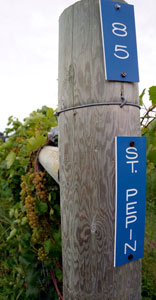
Berry: Spherical and small to medium-sized, has a slipskin and tender flesh; pink juice.
Cluster: Medium to large in size; moderately loose cluster.
Wine Quality & Characteristics: Very fruity, comparable to many German-style white wines and often has a mild labrusca flavor. Some northern growers are making quality ice wine from it. St. Pepin typically has low acidity and average sugar content ranger from 17.6° to 21.0° Brix.
Season: Early Midseason
Cold Hardiness: Hardy to -15° to -20 ° F. Predicted temperature of 50 % primary bud kill is -32° F with no apparent injury to the trunk.
Steuben
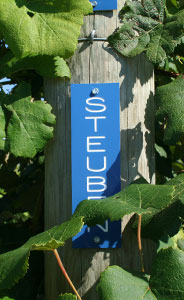
Number of vines: 2,806
Tassel Ridge Wines: Steuben varietal
Pedigree: Wayne & Sheridan
Origin: Geneva, New York. New York State Agricultural Experiment Station, developed by Richard Wellington and George D. Oberle.
Introduction: 1947
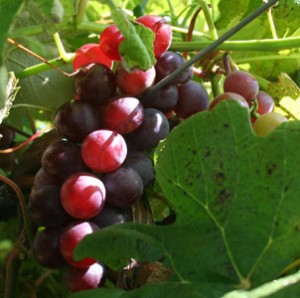
Color: Black
Berry: Medium in size, and elongated by pressure in the cluster.
Cluster: Medium to large .22 lbs to .67 lbs
Wine Quality & Characteristics: Makes an aromatic white, blush or rosé wine. Steuben tends to have a low Brix 19.8° somewhat low pH at 3.2 and low titratable acidity at 5.0 g/liter. Flesh of the grape is slightly tough, juicy, greenish and translucent and the flavor is sweet with a spicy tang. Can make high quality dessert wines also.
Season: Midseason
Cold Hardiness: Hardy -15 to -20 ° F.
